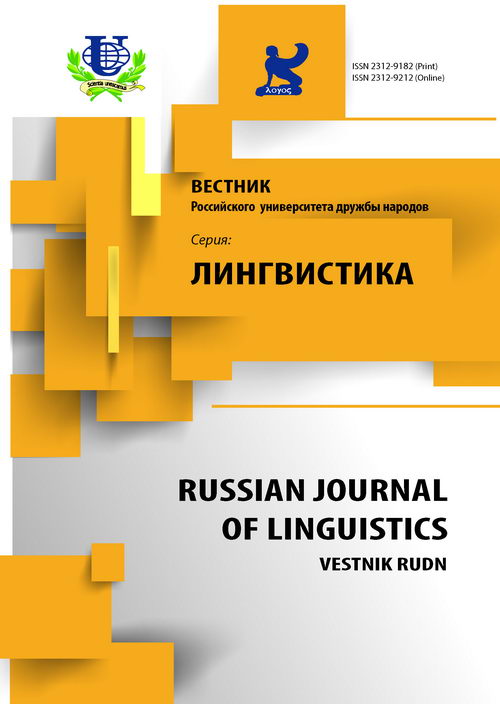Когнитивный диссонанс с позиций межкультурного общения
- Авторы: Леонтович ОА1
-
Учреждения:
- Волгоградский государственный социально-педагогический университет
- Выпуск: Том 19, № 4 (2015)
- Страницы: 49-56
- Раздел: Статьи
- URL: https://journals.rudn.ru/linguistics/article/view/9257
Цитировать
Полный текст
Аннотация
В статье рассматриваются причины, виды и проявления когнитивного диссонанса применительно к межкультурной коммуникации. Возникновение когнитивного диссонанса может быть обусловлено различиями в концептуализации и категоризации действительности через призму различных языков и культур. Гармонизация противоречащих друг другу установок и выход из состояния когнитивного диссонанса базируется на механизмах понимания и взаимодействии с носителями лингвокультуры для преодоления коммуникативных сбоев. Высокий уровень межкультурной компетенции предполагает способность идентифицировать причину когнитивного диссонанса и знание способов выхода из него. Закономерности возникновения когнитивного диссонанса должны учитываться в работе переводчиков и иных специалистов в области межкультурной коммуникации.
Об авторах
О А Леонтович
Волгоградский государственный социально-педагогический университетКафедра межкультурной коммуникации и перевода
Список литературы
- Aksyonov V. V poiskah grustnogo bjebi [In search of a sad baby]. Moscow: Izografus; JeKSMO-Press, 2000.
- Bibik O.P. Jevristicheskij potencial teorii kognitivnogo dissonansa v formirovanii i razvitii filosofskogo znanija [Euristic potential of the theiry of cognitive dissonance in the formation and development of philosophical knowledge]. Doctoral dissertation abstract. Available at: http://www.dissercat.com/content/evristicheskii-potentsial-teorii-kognitivnogo-dissonansa-v-formirovanii-i-razvitii-filosofsk#ixzz3RrDbLldS (accessed 6 March 2015).
- Dem'jankov V.Z. Kognitivnyj dissonans: kognicija jazykovaja i vnejazykovaja [Cognitive dissonance: linguistic and extralinguistic cognition]. In: Kognitivnye issledovanija jazyka [Cognitive study of language]: Vol. IX. Vzaimodejstvie kognitivnyh i jazykovyh struktur [Interaction of cognitive and linguistic structures] / Ed. V.Z. Dem'jankov.- Moscow: Institite of Linguistics RAN; Tambov, 2011. P. 33-40.
- Drozdova T.V. Kognitivnyj dissonans kak lingvisticheskaja problema [Cognitive dissonance as a linguistic problem]. Doctoral dissertation. Tula: Tula State Pedagogical University, 2011.
- Festinger L. A theory of cognitive dissonance. California: Stanford University Press, 1957.
- Knox R.E., Inkster, J.A. Postdecision dissonance at post time. Journal of Personality and Social Psychology. 1968. 8 (4). P. 319-323.
- Mills J. Changes in moral attitudes following temptation. Journal of Personality.1958. 26 (4). P. 517-531.
- Moss N. British/American Language Dictionary. Lincolnwood, Illinois: Passport Books, 1991
- Mussen P.H., Rosenzweig M.R., Blumenthal A.L. Psychology: an introduction. University of Michigan, 1979.
- O’Conner P.T., Kellerman S. ‘Origins of the Specious’. Available at: http://www.nytimes.com/ 2009/05/24/books/chapter-origins-of-the-specious. html?_r=0 (accessed September 30 2015).
- Prasad, J. A comparative study of rumours and reports in earthquakes". British Journal of Psychology. 1950. 41 (3-4). P. 129-144.
- Swami V. The Influence of Body Weight and Shape in Determining Female and Male Physical Attractiveness. In: Body image / ed. M.V. Kindes. Nova Science Publishers, Inc., 2006. P. 35-61.
- Tarmaeva V.I. Kognitivnaja garmonija kak mehanizm interpretacii teksta [Cognitive harmony as a mechanism of text interpretation]. Doctoral dissertation abstract. Kemerovo: Kemerovo State University, 2012.
- Tavris, C., Elliot A. Mistakes were made (but not by me). Pinter and Martin, 2008.
- Veber E.A. Opyt lingvisticheskogo issledovanija kognitivnogo dissonansa v anglijskom diplomaticheskom diskurse [Essay of linguistic study of cognitive dissonance in English diplomatic discourse]. Doctoral dissertation. Irkutsk: Irkutsk State Linguistic University, 2004.

















